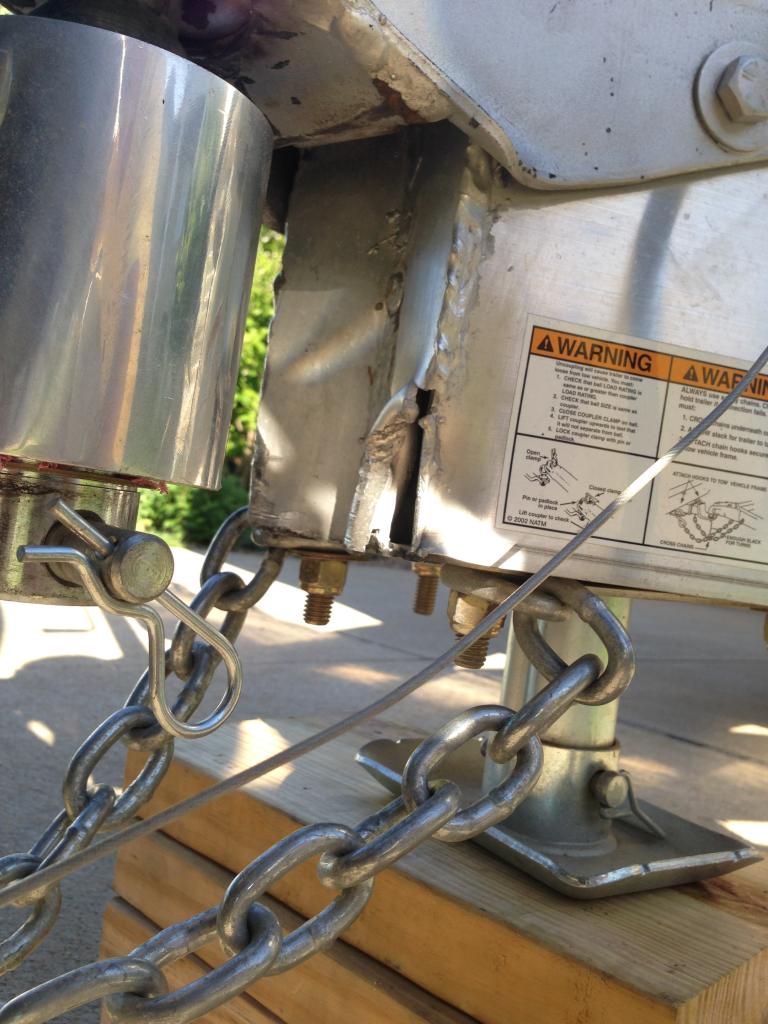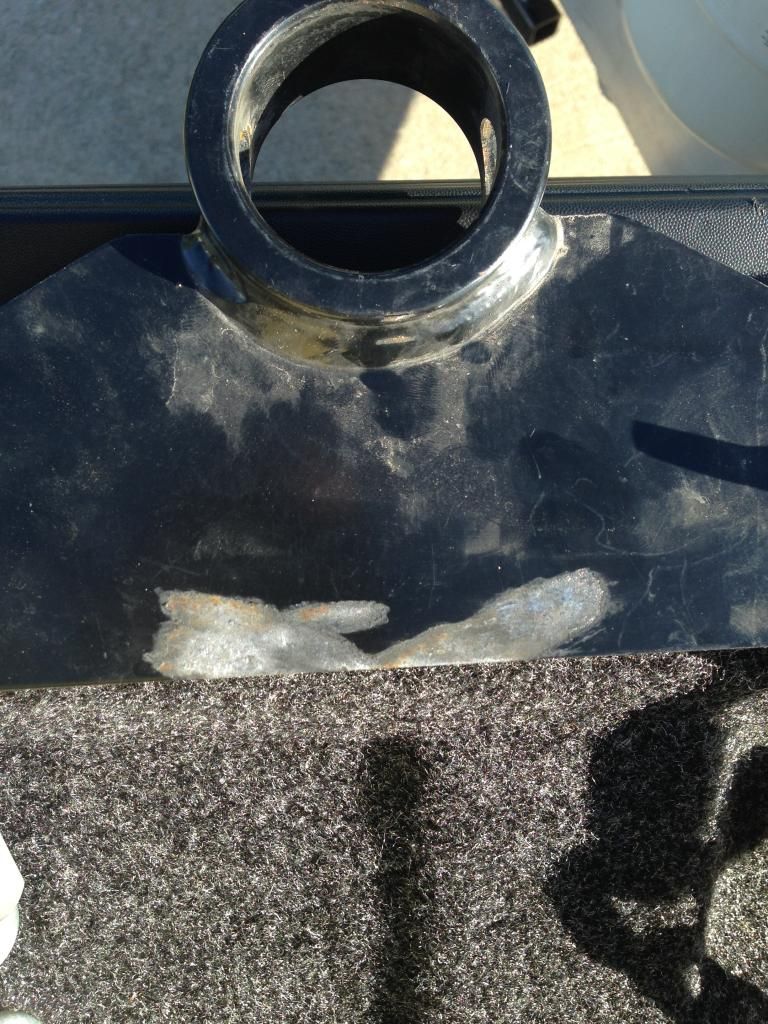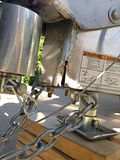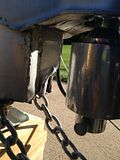- Good Sam Community
- Everything RV
- RV Tips & Tricks
- Re: Did my Andersen No-Sway WDH do this???
- Subscribe to RSS Feed
- Mark Topic as New
- Mark Topic as Read
- Float this Topic for Current User
- Bookmark
- Subscribe
- Mute
- Printer Friendly Page
Did my Andersen No-Sway WDH do this???
- Mark as New
- Bookmark
- Subscribe
- Mute
- Subscribe to RSS Feed
- Permalink
- Report Inappropriate Content
May-29-2014 03:41 AM
I'm not sure, what caused it, but after hooking up last night I noticed chunks of aluminum on the ground under my setup. I had just got my trailer back from service where they move trailers around with fork lifts, so maybe they somehow banged into it? Did the Andersen hitch plate somehow do it? Totally confused, and looking for your thoughts....


Note: Moderator edit to redo picture urls for enlargement.
- Mark as New
- Bookmark
- Subscribe
- Mute
- Subscribe to RSS Feed
- Permalink
- Report Inappropriate Content
Jun-05-2014 01:15 PM
My companies all had those holes in the forks, but they were all used and came
with them
Now that you mention it, the bigger ones we rented/leased may not have had them
as didn't really take notice
As for the weld quality on the tongue...disagree...it is indicative of the whole
trailer's welding quality. Or potential for other spots to have this kind of
weld quality, IMHO
1996 GMC SLT Suburban 3/4 ton K3500/7.4L/4:1/+150Kmiles orig owner...
1980 Chevy Silverado C10/long bed/"BUILT" 5.7L/3:73/1 ton helper springs/+329Kmiles, bought it from dad...
1998 Mazda B2500 (1/2 ton) pickup, 2nd owner...
Praise Dyno Brake equiped and all have "nose bleed" braking!
Previous trucks/offroaders: 40's Jeep restored in mid 60's / 69 DuneBuggy (approx +1K lb: VW pan/200hpCorvair: eng, cam, dual carb'w velocity stacks'n 18" runners, 4spd transaxle) made myself from ground up / 1970 Toyota FJ40 / 1973 K5 Blazer (2dr Tahoe, 1 ton axles front/rear, +255K miles when sold it)...
Sold the boat (looking for another): Trophy with twin 150's...
51 cylinders in household, what's yours?...
- Mark as New
- Bookmark
- Subscribe
- Mute
- Subscribe to RSS Feed
- Permalink
- Report Inappropriate Content
Jun-04-2014 06:16 PM
BenK wrote:Ben, thanks for your reply. Just for the record -- nobody has ever said that the plate got up there and gouged the trailer tongue.
Yes...over lap meaning the trailing edge of the plate is behind the leading edge of the trailer tongue bottom
By about 0.50" to 0.75" is my guess
So for the plate to 'get up there' and gouge the trailer tongue, it would have to move forward or the trailer tongue has to move rearward about 0.50" to 0.75"
That's not how the plate can cause damage to the front of the A-frame.
As the OP said, "
The plate rests under the frame. Or the frame "overlaps" the plate. In other words, the plate cannot ever raise past the bottom of the frame. All the plate can do it rub and put pressure on the bottom of the frame.
"The plate can and does exert an upward force on the lowest part of the front of the frame.
From the other photos, it appears that the lowest point is the bottom of the weld bead on the left (drivers) side.
The rear of the plate also can and does move laterally relative to the TT frame due to relative rotation between plate and TT.
This generates a friction force, which can push the bottom of the weld bead laterally, in addition to the upward force on the bead.
There is no need for the plate to "gouge" the frame to do damage.
Regarding "gouging" -- I believe the following photo gives a false impression about a gouge or gouges on the bead and end of the A-frame.
I agree, there does seem to be a major indentation in the weld bead just below the curved portion.
However, if you look at the second photo, I think you will get a very different impression.

Now look at this photo of the same weld bead, taken more recently under different lighting conditions.
The apparent indentation in the previous photo is not there.
However, there does appear to be a slightly-curved weld defect (void) running at an oblique angle at about the same location as the apparent indentation.
Also note that, when in its original position, virtually all of the bead material would have been to the right of the end of the frame.
It would have been impossible for a fork to move the bead to the right without hitting the end of the frame.
And, as far as I can see, there is no evidence of any fork damage on the outside of the end of the frame.

The above photo shows almost complete lack of fusion between bead and base metal.
IMO, it would have been easy for a lateral friction force acting on the bottom end of the bead to separate the bottom portion of the bead from the frame.
At the same time, the upward force on the bead could cause the buckling and cracking at the top of the bead.
That's my interpretation of the photos -- yours might vary.
Ron
- Mark as New
- Bookmark
- Subscribe
- Mute
- Subscribe to RSS Feed
- Permalink
- Report Inappropriate Content
Jun-04-2014 01:35 PM

That damage didn't come from the hitch plate on the TV side. That lower plate would make a make the same thickness (height on the trailer) of a quarter inch or whatever size it is, rather than a 3/4 - 1" high tear we see here.
I'm betting this was buggered up by the guy jockeying it around the yard when it was at the service place.....I'd go investigate their trailer mover adapter they have on the forklift and I'll bet jackknifing it would match that damage.....
- Mark as New
- Bookmark
- Subscribe
- Mute
- Subscribe to RSS Feed
- Permalink
- Report Inappropriate Content
Jun-04-2014 10:44 AM
BTW, most larger RV dealer don't mount the ball directly to the folks. It violates both ANSI and OSHA standards, which means if they lease their forklifts it will be explicitly not allowed by the forklift dealer (to the point the larger chains won't even service them if the forks are modified). Fork adapter simply work better because they are less likely to interfere, and they will work with customers hitches like a Hensley.

2014 ORV really big trailer
2015 Ford Focus ST
- Mark as New
- Bookmark
- Subscribe
- Mute
- Subscribe to RSS Feed
- Permalink
- Report Inappropriate Content
Jun-04-2014 10:00 AM

Notice that the gouged (bent up and to the side) still has the weld bead but
the other half of that welded seam is straight.
It should have been melted by the MIG arc and fused with both the other half
and the MIG wire
If melted and fused, it should have torn and left a torn edge, not a straight
edge shown
Also, why the tear ended where it did...the welded bead above that
did do what it is supposed to do...melt and fuse the three (tow sheet
metal halves with the filler wire)
This is a common high rate production issue. The welds 'look' just fine, but
the bead did not 'stick', nor did it melt both sides
Not so common for TIG, as most use a manual filler rod feed along with a manual
torch. There are some automatic wire fed TIG, but mostly for smaller stuff. Like
some high end alu bicycles (not so much anymore now that plastic is the high end
bike material)
1996 GMC SLT Suburban 3/4 ton K3500/7.4L/4:1/+150Kmiles orig owner...
1980 Chevy Silverado C10/long bed/"BUILT" 5.7L/3:73/1 ton helper springs/+329Kmiles, bought it from dad...
1998 Mazda B2500 (1/2 ton) pickup, 2nd owner...
Praise Dyno Brake equiped and all have "nose bleed" braking!
Previous trucks/offroaders: 40's Jeep restored in mid 60's / 69 DuneBuggy (approx +1K lb: VW pan/200hpCorvair: eng, cam, dual carb'w velocity stacks'n 18" runners, 4spd transaxle) made myself from ground up / 1970 Toyota FJ40 / 1973 K5 Blazer (2dr Tahoe, 1 ton axles front/rear, +255K miles when sold it)...
Sold the boat (looking for another): Trophy with twin 150's...
51 cylinders in household, what's yours?...
- Mark as New
- Bookmark
- Subscribe
- Mute
- Subscribe to RSS Feed
- Permalink
- Report Inappropriate Content
Jun-04-2014 09:54 AM
BenK wrote:
Yes...over lap meaning the trailing edge of the plate is behind the leading edge
of the trailer tongue bottom
By about 0.50" to 0.75" is my guess
So for the plate to 'get up there' and gouge the trailer tongue, it would have
to move forward or the trailer tongue has to move rearward about 0.50" to 0.75"
An interference or overlap
As for the OEM claim....the first series of pictures the OP posted both shows
the gouged area
Notice that one side of the weld still has a straight edge from the sheetmetal
shear.
If welded correctly, it should NOT be a straight edge, but a torn edge because
the tow sheetmetal sides 'should' have been melted and fused into one.
That is a workmanship issue and quality issue of the trailer OEM and
has nothing to do with the current RV service folks who tore the
tongue with their fork lift's fork edge...other than the current RV
service folks exposed that lack of quality workmanship. Otherwise that
would have been hidden forever or until some other event
Still think the Anderson is an elegant architecture, but a poor example of their
design attributes
OP...ask how you secured the Anderson brackets to your tongue? Did you use their
pointed gouge set screws? Or did you drill holes in the aluminum tongue? Welded?
Again ask if you can post some pictures of your latch looking at it from the inside
of the coupling.
I can take pics of the coupler after i get the trailer back from service. I never attached the set screws. Just bolted the brackets to the frame and the have not moved.
- Mark as New
- Bookmark
- Subscribe
- Mute
- Subscribe to RSS Feed
- Permalink
- Report Inappropriate Content
Jun-04-2014 09:53 AM
Notice how the ball is a distance from the fork end...that is about where the
coupler's ball dome is on the OP's trailer tongue
Then the distance from the ball center-line to the fork end is about the distance
the OP's trailer tongue setup is
The different heights of the marks on the OP's tongue says to me, that the
area moved was not even and/or the fork was set at different angles, which
says maybe moved several times (each time the fork's tilt was not the same)
1996 GMC SLT Suburban 3/4 ton K3500/7.4L/4:1/+150Kmiles orig owner...
1980 Chevy Silverado C10/long bed/"BUILT" 5.7L/3:73/1 ton helper springs/+329Kmiles, bought it from dad...
1998 Mazda B2500 (1/2 ton) pickup, 2nd owner...
Praise Dyno Brake equiped and all have "nose bleed" braking!
Previous trucks/offroaders: 40's Jeep restored in mid 60's / 69 DuneBuggy (approx +1K lb: VW pan/200hpCorvair: eng, cam, dual carb'w velocity stacks'n 18" runners, 4spd transaxle) made myself from ground up / 1970 Toyota FJ40 / 1973 K5 Blazer (2dr Tahoe, 1 ton axles front/rear, +255K miles when sold it)...
Sold the boat (looking for another): Trophy with twin 150's...
51 cylinders in household, what's yours?...
- Mark as New
- Bookmark
- Subscribe
- Mute
- Subscribe to RSS Feed
- Permalink
- Report Inappropriate Content
Jun-04-2014 09:40 AM
of the trailer tongue bottom
By about 0.50" to 0.75" is my guess
So for the plate to 'get up there' and gouge the trailer tongue, it would have
to move forward or the trailer tongue has to move rearward about 0.50" to 0.75"
An interference or overlap
As for the OEM claim....the first series of pictures the OP posted both shows
the gouged area
Notice that one side of the weld still has a straight edge from the sheetmetal
shear.
If welded correctly, it should NOT be a straight edge, but a torn edge because
the tow sheetmetal sides 'should' have been melted and fused into one.
That is a workmanship issue and quality issue of the trailer OEM and
has nothing to do with the current RV service folks who tore the
tongue with their fork lift's fork edge...other than the current RV
service folks exposed that lack of quality workmanship. Otherwise that
would have been hidden forever or until some other event
Still think the Anderson is an elegant architecture, but a poor example of their
design attributes
OP...ask how you secured the Anderson brackets to your tongue? Did you use their
pointed gouge set screws? Or did you drill holes in the aluminum tongue? Welded?
Again ask if you can post some pictures of your latch looking at it from the inside
of the coupling.
1996 GMC SLT Suburban 3/4 ton K3500/7.4L/4:1/+150Kmiles orig owner...
1980 Chevy Silverado C10/long bed/"BUILT" 5.7L/3:73/1 ton helper springs/+329Kmiles, bought it from dad...
1998 Mazda B2500 (1/2 ton) pickup, 2nd owner...
Praise Dyno Brake equiped and all have "nose bleed" braking!
Previous trucks/offroaders: 40's Jeep restored in mid 60's / 69 DuneBuggy (approx +1K lb: VW pan/200hpCorvair: eng, cam, dual carb'w velocity stacks'n 18" runners, 4spd transaxle) made myself from ground up / 1970 Toyota FJ40 / 1973 K5 Blazer (2dr Tahoe, 1 ton axles front/rear, +255K miles when sold it)...
Sold the boat (looking for another): Trophy with twin 150's...
51 cylinders in household, what's yours?...
- Mark as New
- Bookmark
- Subscribe
- Mute
- Subscribe to RSS Feed
- Permalink
- Report Inappropriate Content
Jun-03-2014 02:41 PM
Ron Gratz wrote:BenK wrote:Ben, I really am trying to understand what you're saying. So -- I hope you don't mind some questions for clarification.
This image says it all to me...
Looks like approx 0.50" to 0.75" or so over lap
When you refer to "overlap" -- what is overlapping what?With that kind of over lap or potential interference...there is no way it would NOT have torn a much BIGGER gougeWhat are you talking about when you refer to "it". IOW, what would have torn a much bigger gouge?Plus, with that kind of over lap, don't think it could raise high enough to do what your original pictures shows without messing up the bottom on it's way up thereAgain, what is "it", and how high would "it" have had to rise to cause whatever damage is shown by the original pictures?Another betcha that their fork end will match up with the marks AKA like a bullet's riflingWhich "marks" are you referring to? Member opnspaces, on 06/02/14 04:40pm, referred to "at least four horizontal marks that match across both sides of the tongue." Are you referring to the same marks?Repeat...you have two claims or that I'd have if meCan you please describe the scenario which you believe caused the damage?
#1 against the service company and their fork lift
How do you think the forklift was being maneuvered, and what part of the fork hit what part of the tongue?#2 against the trailer OEM for workmanshipAssuming the fork tip did, in fact, make contact with the tongue, do you really believe that better "workmanship" would have resulted in no damage?
Ron
I know what he means by overlap which is what I've been trying to explain. The plate rest underthe frame. Or the frame "overlaps" the plate. In other words, the plate cannot ever raise past the bottom of the frame. All the plate can do it rub and put pressure on the bottom of the frame.
On a side note....
I just dropped the trailer off at the servicer to finish the work they were supposed to do over the last few weeks. As soon as I dropped it off the service tech looked at the hole in the frame and said "We'll take care of that." He didn't admit to anything, but that's okay by me so long as it get's fixed.
I am of the opinion that the Andersen is not designed properly for my set up having 8" frame rails. It would be fine if the ball shank were longer which would lower the plate. Not sure that is even possible. I love, love, love the Andersen WDH, but it may not be right for me. Expensive lesson really, but oh well....
- Mark as New
- Bookmark
- Subscribe
- Mute
- Subscribe to RSS Feed
- Permalink
- Report Inappropriate Content
Jun-03-2014 02:11 PM
BenK wrote:Ben, I really am trying to understand what you're saying. So -- I hope you don't mind some questions for clarification.
This image says it all to me...
Looks like approx 0.50" to 0.75" or so over lap
When you refer to "overlap" -- what is overlapping what?
With that kind of over lap or potential interference...there is no way it would NOT have torn a much BIGGER gougeWhat are you talking about when you refer to "it". IOW, what would have torn a much bigger gouge?
Plus, with that kind of over lap, don't think it could raise high enough to do what your original pictures shows without messing up the bottom on it's way up thereAgain, what is "it", and how high would "it" have had to rise to cause whatever damage is shown by the original pictures?
Another betcha that their fork end will match up with the marks AKA like a bullet's riflingWhich "marks" are you referring to? Member opnspaces, on 06/02/14 04:40pm, referred to "at least four horizontal marks that match across both sides of the tongue." Are you referring to the same marks?
Repeat...you have two claims or that I'd have if meCan you please describe the scenario which you believe caused the damage?
#1 against the service company and their fork lift
How do you think the forklift was being maneuvered, and what part of the fork hit what part of the tongue?
#2 against the trailer OEM for workmanshipAssuming the fork tip did, in fact, make contact with the tongue, do you really believe that better "workmanship" would have resulted in no damage?
Ron
- Mark as New
- Bookmark
- Subscribe
- Mute
- Subscribe to RSS Feed
- Permalink
- Report Inappropriate Content
Jun-03-2014 09:04 AM

Looks like approx 0.50" to 0.75" or so over lap
With that kind of over lap or potential interference...there is no way
it would NOT have torn a much BIGGER gouge
Plus, with that kind of over lap, don't think it could raise high enough
to do what your original pictures shows without messing up the bottom
on it's way up there
Gotta be the service folks and their fork lift
Another betcha that their fork end will match up with the marks AKA like
a bullet's rifling
To the comment that is okay to have this kind of damage...not for me
as think of the whole trailer's forces all focused on the coupler, FACT
That then has the rest of the tongue transfer those forces between
the truck and trailer via that tongue...
Sure okay for a while, but how about over time?
Repeat...you have two claims or that I'd have if me
#1 against the service company and their fork lift
#2 against the trailer OEM for workmanship
1996 GMC SLT Suburban 3/4 ton K3500/7.4L/4:1/+150Kmiles orig owner...
1980 Chevy Silverado C10/long bed/"BUILT" 5.7L/3:73/1 ton helper springs/+329Kmiles, bought it from dad...
1998 Mazda B2500 (1/2 ton) pickup, 2nd owner...
Praise Dyno Brake equiped and all have "nose bleed" braking!
Previous trucks/offroaders: 40's Jeep restored in mid 60's / 69 DuneBuggy (approx +1K lb: VW pan/200hpCorvair: eng, cam, dual carb'w velocity stacks'n 18" runners, 4spd transaxle) made myself from ground up / 1970 Toyota FJ40 / 1973 K5 Blazer (2dr Tahoe, 1 ton axles front/rear, +255K miles when sold it)...
Sold the boat (looking for another): Trophy with twin 150's...
51 cylinders in household, what's yours?...
- Mark as New
- Bookmark
- Subscribe
- Mute
- Subscribe to RSS Feed
- Permalink
- Report Inappropriate Content
Jun-02-2014 04:40 PM
Ron Gratz wrote:09KZMXT266 wrote:Did you have the damaged weld repaired before going on the latest 600 mile tow?
---Also, i just got home from another 600 mile tow. No additional damage that I can see with the exception of some additional rub marks on the plate.
Can you post a photo of the additional rub marks on the plate?
Ron
No, I left right after picking it up for a weekend trip, so nothing is fixed. Here are some pics from tonight....




- Mark as New
- Bookmark
- Subscribe
- Mute
- Subscribe to RSS Feed
- Permalink
- Report Inappropriate Content
Jun-02-2014 03:53 PM
09KZMXT266 wrote:Did you have the damaged weld repaired before going on the latest 600 mile tow?
---Also, i just got home from another 600 mile tow. No additional damage that I can see with the exception of some additional rub marks on the plate.
Can you post a photo of the additional rub marks on the plate?
Ron
- Mark as New
- Bookmark
- Subscribe
- Mute
- Subscribe to RSS Feed
- Permalink
- Report Inappropriate Content
Jun-02-2014 02:40 PM
The scuff marks on the plate might explain the weld separating, but they don't explain how the aluminum got lifted torn and folded like it is. That lifting and tearing is from something besides a flat plate rubbing on the bottom of the frame.
If you look at the two pictures you can see where the forklift rammed into the tip of the tongue at least 4 different times as they were picking up and moving the trailer. There are at least four horizontal marks that match across both sides of the tongue. These marks are either from the flat Anderson plate or a forklift tip. They cannot be from the plate as the tow ball will not physically allow the plate to be that high on the tongue so that leaves the forklift.
My guess is that on one of the moves the lot guy was overconfident and under experienced. He came in a bit off center and started the forks going up at the same time as the ball was near where it should go. His intent was a smooth in and up motion and he misjudged or was using a different forklift and jammed the fork tip into the aluminum tongue while the forks were rising. The end result was he took the frame end that was poorly welded or already separated from the plate rubbing, and ripped it up and back.
If you look at the first picture you can see the rectangular mark where the fork tip was buried in the fold of the crease as it went up.
OP, if you truly want the truth the only way to find out is to take the trailer back and have them put the forklift tip up under the tongue. I think at that time it will be obvious if the forklift is at fault.
I would probably be more curious though if this tear has compromised the strength of the tongue. My guess is that it does not and the end cap is really cosmetic. But I don't really know metallurgy to answer the question.
2001 Suburban 4x4. 6.0L, 4.10 3/4 ton **** 2005 Jayco Jay Flight 27BH **** 1986 Coleman Columbia Popup
- Mark as New
- Bookmark
- Subscribe
- Mute
- Subscribe to RSS Feed
- Permalink
- Report Inappropriate Content
Jun-02-2014 02:18 PM
2004 GMC 2500HD Crew Cab Duramax Diesel
1999 Dodge 1500 5.9L Gas





